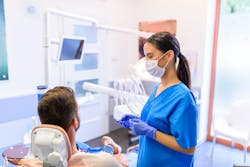Voice-activated periodontal charting: Solution to a common problem
Editor's note: This article first appeared in the March 2021 issue of RDH magazine titled "Eliminating the double-edged sword."
Having been a private consultant to successful dental practices for as long as I have, I’ve come to appreciate hygienists face similar challenges no matter where they are. Here is a big one: It is imperative to collect, assimilate, interpret, and communicate detailed diagnostic information related to the patient’s current periodontal status each visit; yet, time to accomplish that task is often elusive and inadequately allotted for.
It can become a double-edged sword for hygienists. Avoid accurately assessing the patient’s current periodontal status at the beginning of the appointment, and you may end up in a bloody-prophy nightmare that is a disservice to patients, to say the least. But, carve out time to accurately assess and communicate the current periodontal status, and there may be inadequate time left in the appointment to complete necessary services, especially if patients question their status. (“So, why do my gums only bleed here and not at home?”)
For those of you using voice-activated technology to accurately and efficiently collect and assimilate periodontal data, you cannot imagine practicing without it. However, we are the minority. Many clinicians today struggle to allocate time in a busy appointment to perform six-point probing, record bleeding sites, measure recession, identify Class I furcations, record all of the data without assistance, and interpret the diagnostic information to drive treatment decisions. It can be overwhelming.
In scenarios where clinicians have daily production goals, or their salary is a percentage of billable services, it can be tempting to think, “I’ll gather all of that detailed data . . . next time” and simply settle for generalized data such as, “Moderate bleeding, especially around posterior teeth. Generalized 3-4 mm pockets with isolated 5 mm pockets around molars. Stressed importance of flossing. Reevaluate next visit.” I’ve read versions of these types of assessments and chart notes for years in practices all across North America. If this sounds familiar to you, I have good news. Voice-activated periodontal charting can change your life, and it goes without saying it can enable early diagnosis of periodontal conditions. It solves the double-edged sword dilemma.
OK, now I’m going to ask some tough questions. Please consider the health of your patients as you consider and answer these questions honestly.
How many of your patients have zero evidence of gingivitis or periodontitis? For all of those who present with evidence of periodontal inflammation, is a diagnosis and treatment plan included in services provided?
What percentage of your procedures actually become bloody prophys, as reflected in the patient’s chart notes?
How many of your patients have Class I or Class II furcations that have not been documented or specifically treated?
How many of your patients have inflammation around their implants but do not have a diagnosis or treatment plan to do anything differently than what they were doing, which enabled the condition to develop in the first place?
How many of your patients have a diagnosis for restorative or esthetic treatment that requires a healthy foundation in order to achieve the most optimal outcome?
If it feels as though I’m stepping on your toes with these questions, well, maybe I am. However, I earned that right because I had mine stepped on early in my career when I was a darn good hygienist, but drowning in the midst of one bloody prophy after another. Thankfully, I figured out how to eliminate the double-edged sword, and my patients have been healthier ever since. A key to turning around this scenario is a commitment from the entire team that a healthy foundation should be the priority to all esthetic and restorative services provided in dentistry. Second, having a system to efficiently and accurately collect diagnostic data on every patient makes it realistic to accomplish that goal.
While there are several voice-activated periodontal data collection systems available, the system that I have used since 1997 is Florida Probe, and most recently VoiceWorks by Florida Probe. VoiceWorks is a hands-free technology that eliminates cross-contamination that can occur when single users attempt to enter data on the computer simultaneously with probing. Single-user data collection can be very time-consuming when moving between the patient and the computer to enter all data manually.
No other team member is required to enter data with VoiceWorks, as the voice-activated headset seamlessly enters the data on the computer while the patient listens. A common question from patients upon hearing their own periodontal assessments being entered into the computer is, “Wow, what do I need to do next?” or “How bad is it?” since they hear each bleeding site and each pocket depth being recorded. When patients are engaged in their own periodontal assessments, the transition into discussions about how to treat gingivitis, periodontitis and peri-implantitis are simplified and expedited.
I recently had a patient say, “I’ve never had this done before,” followed by, “I wonder why?” To be honest, I agree. I wonder why every clinician practicing today isn’t seeking an immediate solution to the double-edged sword that has been problematic for as long as I have been practicing: We need accurate data each visit. It is cumbersome to collect it all. Imagine—eliminating this problem will enable your patients to be healthier, with an unexpected return on investment for the dental practice that can easily transition into periodontal treatments as indicated. It’s time we get rid of the double-edge sword facing dental hygienists. The technology exists. It works. It isn’t costly or difficult. Wow, what a smart investment!
About the Author
Karen Davis, BSDH, RDH
Karen Davis, BSDH, RDH, is the founder of Cutting Edge Concepts, an international continuing education company. She practices dental hygiene in Dallas, Texas. She is an independent consultant to the Philips Corporation, Periosciences, Hu-Friedy Group, and EMS. She can be reached at [email protected].



